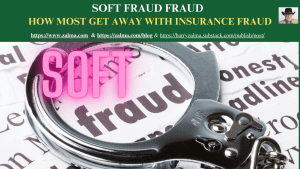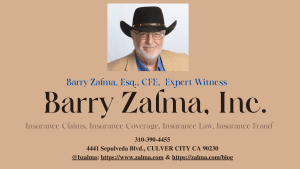Soft Fraud

Post 4764
See the full video at https://rumble.com/v4luxm2-soft-fraud.html and at https://youtu.be/52DjezN4OX8
For reasons known only to governmental entities some insist on categorizing fraud into both “hard” and “soft” fraud. By so doing the governmental entities that so categorize fraud make one type of fraud less heinous and less criminal than the other. Fraud, whether categorized “soft” or “hard,” are criminal and if a person is tried and convicted of fraud both can be sent to jail for the same amount of time.
The types of insurance fraud some call “soft fraud” are found in every type of claim presented to an insurer.
Soft fraud, which is sometimes called opportunity fraud, occurs when a policyholder or claimant exaggerates a legitimate claim…. According to the Insurance Research Council, soft fraud is far more frequent than hard fraud. Because of the frequency of soft fraud, it adds more to overall claims cost than hard fraud does.
Soft fraud occurs when a policyholder exaggerates an otherwise legitimate claim or when an individual applies for an insurance policy and lies about certain conditions or circumstances to lower the policy’s premium.
The reality is that Soft Fraud is a criminal violation and a breach of a material condition of the policy. It contributes to increased insurance costs. As a result of increased insurance costs, millions of Americans cannot afford sufficient insurance coverage. One cannot commit an innocent or partial fraud any more than one can be partially dead. Once fraud is committed the contract of insurance is violated and voidable and the crime has been committed.
Soft fraud, in contrast, usually involves legitimate losses that are exaggerated by the policyholder. For example, if a person is in a car accident and files a claim with her auto insurance company but overstates the severity of the damage to her car. The insured did not fabricate the accident or the underlying claim, but nevertheless committed soft fraud by not being completely truthful with the insurance company.
Regardless of whether or not the fraudulent act is soft or hard, insurance fraud is a felony under the law of most states.
The discussion that follows describes the most insidious and prevalent types of soft fraud.
PADDING
Padding is found when injuries or damages are exaggerated to increase a claim’s value. It is what has been called an insidious type of fraud difficult to detect and often considered harmless by insureds, claimants, police, and prosecutors.
Padding can come in a variety of forms. In first party claims, an insured is generally considered to be in the best position to know the value of property for which he or she is making a claim. An insurer depends upon the insured to provide an honest description and estimate of the value of the property, and most courts hold an insured to a high level of honesty when reporting a loss to an insurer.
Padding is found in property insurance when insureds inflate the number of items lost or destroyed or exaggerate the value of the items claimed damaged, destroyed, or stolen. This can be as simple as increasing the size of a stolen television from 32 inches to 42 inches; from a cathode ray tube to flat screen; from $100 cash to $500 cash; or from two pairs of jeans to five pair.
According to an Insurance Research Council (IRC) study, approximately 90 percent of the costs of insurance fraud are the result of claims padding. Claimants add damage, injuries, and fictitious passengers to their insurance claims. The other 10 percent are the result of organized accident staging rings. Because of the sheer number of offenders, and the light sentences received by the few that are convicted, pursuing these crimes has not a priority for law-enforcement or insurers. [Whyen v. Summers, 58 Misc.3d 1223(A), 97 N.Y.S.3d 57 (Table) (N.Y. Sup. Ct., 2018)]
On third party claims the padding can be as simple as adding a week of lost earnings that, in fact, was not lost; allowing the doctor to bill for three visits not made; or going to a chiropractor who charges for x-rays not taken.
Standard fire insurance, all-risk property insurance, package first party property policies and most third party liability policies state that the policy is void if the insured intentionally conceals or misrepresents any material fact or circumstance about the insurance or a claim, whether before or after the loss.
When an insured submits fraudulent invoices to inflate a claim the insurer has the right, under the policy wording, to void the entire policy. The insured’s argument that he was entitled to recover that part of his claim not supported by fraudulent documents should be dismissed out of hand. One cannot commit a small fraud any more than a person can be just a little dead.
A slight misstatement of value normally will not be sufficient to allow an insurer to void an insurance policy for fraud unless the insured knew at the time the misstatement was made that the statement was false and the insurer can prove that the misstatement was made with the intent to deceive it. Misrepresentation, concealment, and fraud are not limited by the amount of the fraud but by the intent of the person making the claim. An insured who presents, with the intent to defraud, $1,000 in false invoices is as culpable as an insured who presents, with the intent to defraud, $1,000,000 in false claims. In both cases, if proved, the policy of insurance, by its terms and conditions, is void and the claim is forfeited.
If the differences in numbers between those presented by the insured and those presented by the insurer are honest differences of opinion or calculation errors a policy cannot, and should not, be declared void. The insured must intend to deceive and the insurer must be in a position to prove that intent and that it was deceived before it can void the policy.
Honest people deceive their insurers. They think the deception is just harmless fudging. “Soft fraud” wrongfully takes money from an insurer and is also a crime. Soft fraud, like hard fraud, raises everyone’s insurance costs. The greatest amount of money lost to fraud is lost to schemes designated as “soft fraud.” Since most soft fraud succeeds the amount it costs the insurance industry is difficult, if not impossible, to determine. Prosecuting some “soft fraud” perpetrators can put the fear of prison in the minds of the general public and save more money, in the long run, than prosecuting and convicting a single major fraud perpetrator. Unfortunately, police and prosecutors are often unwilling to prosecute cases of so-called “soft fraud” even when the evidence is damning.
Years ago, the author took the Examination Under Oath of an insurance broker who inflated a claim for damage to personal property by creating, with the use of white out paint and a photocopy machine, fake invoices for the replacement of property never replaced to collect the difference between actual cash value and replacement cost value. At Examination Under Oath the insured admitted to faking the receipts and was eventually convicted of insurance fraud and served a few months in jail for her crime.
Insurance fraud is working to destroy the economy and the ability of insurers to service their clients properly. States attempt to deter it by enacting statutes making it a crime to defraud an insurer and make the insurers, by statute, to investigate and enforce the crime. Yet prosecutors don’t like insurance fraud cases because they are document heavy and no person has been physically injured. Prosecution of insurance fraud is anemic and prosecution of soft fraud is non-existent. Learn from this and defeat fraudulent claims by refusing to pay. You will have no help from police or prosecutors but you can deter the attempts to defraud a proactive insurer.
This blog was adapted from my book “Insurance Fraud – Volume One available on Amazon.com
 (c) 2024 Barry Zalma & ClaimSchool, Inc.
(c) 2024 Barry Zalma & ClaimSchool, Inc.
Please tell your friends and colleagues about this blog and the videos and let them subscribe to the blog and the videos.
Subscribe to my substack at https://barryzalma.substack.com/publish/post/107007808
Go to X @bzalma; Go to Newsbreak.com https://www.newsbreak.com/@c/1653419?s=01; Go to Barry Zalma videos at Rumble.com at https://rumble.com/c/c-262921; Go to Barry Zalma on YouTube- https://www.youtube.com/channel/UCysiZklEtxZsSF9DfC0Expg.
Go to the Insurance Claims Library – https://lnkd.in/gwEYk
Like this:
Loading…


